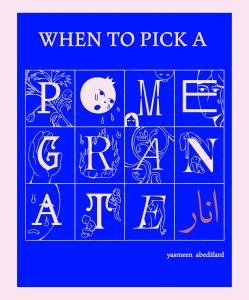
Cartoonist: Yasmeen Abedifard
Publisher: Silver Sprocket / $14.99
September 2024
The deeper in you go, the darker and stranger When to Pick a Pomegranate becomes. A strange book from the start, to be sure, but the tiny voice inside the innocent biological science film strip gets trapped, twisted, ripped apart. Disgust becomes lust, begets more disgust, and begins again. This time teeth pierce flesh, rending the fruit, buzzing and sticky. Meaning and feeling come together like bitten lips. Yasmeen Abedifard’s graphic novel is sensual, rotten with loathing, uncomfortably relatable. A series of encounters between two strangers in the garden that mirror the blossoming and entropy of the pomegranate fruit? Nope.
When to Pick a Pomegranate is a defiance of conventions. Stories of shared experience turn their focus to unnatural compulsions and inner turmoil. Horrible and mundane confrontations inspire darker thoughts, twisted fantasies, anxiety. Disa Wallander meets EM Carroll. Raw like Sophia Foster-Diminio with moments of artistic complexity approaching Michael DeForge. Abedifard shares Wallander’s interest in photographic, textural backgrounds and Snufkinesque simple characters/philosophical pondering. Rather than a talking head in an empty square, the American Splendor old school indie comic vibe, Anar (pomegranate person) and Guli (naked lady) float in space. Each is placed in God’s hands, for Him to smoosh them together like so much clay. With closed palms, the story opens.
As each part repositions Anar and Guli’s relationship, Abedifard dramatically changes the color key to the comic. There are title cards like “Flower,” “Ripe,” and “Rotten,” but the first two have page colors that make the former look like pebbled glaze on a clay pot and the latter the fine lines baked into porcelain. The third is the color of the pomegranate, the consumed husk, ink drops speckled like mold.
Unsettling, beautiful. Haunting. It comes off as a series but really it is a graphic novel with each chapter written in a strikingly different style. The two through-lines are the two SF-D-like characters, stricken with consuming sadness, relatable despite their alien appearance or impossible experiences. And- in each story is inescapable darkness. To go on and carry forward, when every morning the sun must rise, Anar and Guli keep on doubting, suffering and yearning. Doesn’t matter the page color, there will always be growth, and then decay.
Life is a sad story, right? The seed splits open, the sprout twists up to emerge from the dirt. Violence. The blossom falls under its own weight; alas that they are so, to die even when they to perfection grow. Worse still, after rot and return to earth isn’t rest but the birth of another seed. There’s no stopping life. Despite the horrors within (this comic not life), Pomegranate compels its readers to experience pure desire. Horror and desire are twisted up together, the roots to feed the story’s blooming.
That said, it is also a tightly constructed, immaculately measured creation. The color schemes for each comic push the mood into giallo aesthetics territory. Their sequence plays each story against the palette that preceded it. Abedifard and Silver Sprocket have put together a book that is very satisfyingly produced, one where the power of the stylized art is inseparable from the impact the object makes on whoever holds it. A misstep in storytelling takes you out of the moment; Pomegranate makes you conscious of the moment in a way that elevates the story.
And the intention in Abedifard’s visual presentation is matched in its variety by the ways she tells When to Pick a Pomegranate’s stories. Some feel like watching a scene through the window of the panel, time passing through the gutters that separate them, a normal comic. Some are a series of images, their meanings explained one after another, like a sequence of tarot cards laid out in a grid. Some float on the page, little Anar, little Guli. God’s disembodied voice cannot be contained in a box, it floats too. SO WHAT DID YOU LEARN?
When to Pick a Pomegranate is available from Silver Sprocket or wherever finer comics and books are sold.
Source link